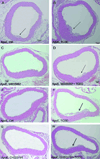Activation of aryl hydrocarbon receptor induces vascular inflammation and promotes atherosclerosis in apolipoprotein E-/- mice
- PMID: 21441140
- PMCID: PMC3098318
- DOI: 10.1161/ATVBAHA.110.220202
Activation of aryl hydrocarbon receptor induces vascular inflammation and promotes atherosclerosis in apolipoprotein E-/- mice
Abstract
Objective: Exposure to dioxins has been shown to contribute to the development of inflammatory diseases, such as atherosclerosis. Macrophage-mediated inflammation is a critical event in the initiation of atherosclerosis. Previously, we showed that treatment of macrophages with 2,3,7,8-tetrachlorodibenzo-p-dioxin (TCDD) leads to aryl hydrocarbon receptor (AhR)-dependent activation of inflammatory mediators and the formation of cholesterol-laden foam cells. However, the mechanisms responsible for the formation of atherosclerotic lesions mediated through AhR have not been identified.
Methods and results: An in vitro macrophage and an apolipoprotein E (ApoE)-/- mouse model were used to determine whether chemokines and their receptors are responsible for the AhR-mediated atherogenesis. Exposure of ApoE-/- mice to TCDD caused a time-dependent progression of atherosclerosis, which was associated with induction of inflammatory genes, including interleukin-8, as well as F4/80 and matrix metalloproteinase-12. A high-fat diet enhanced the TCDD-mediated inflammatory response and aggravated the formation of complex atheromas. Treatment with a CXCR2 inhibitor and an AhR antagonist reduced the TCDD-induced progression of early atherosclerotic lesions in ApoE-/- mice.
Conclusion: The results suggest that CXCR2 mediates the atherogenic activity of environmental pollutants, such as dioxins, and contributes to the development of atherosclerosis through the induction of a vascular inflammatory response by activating the AhR-signaling pathway.
Conflict of interest statement
No conflict of interest is declared.
Figures





Comment in
-
Another important biological function for the aryl hydrocarbon receptor.Arterioscler Thromb Vasc Biol. 2011 Jun;31(6):1247-8. doi: 10.1161/ATVBAHA.111.227553. Arterioscler Thromb Vasc Biol. 2011. PMID: 21593454 No abstract available.
References
-
- Pelclova D, Fenclova Z, Preiss J, Prochazka B, Spacil J, Dubska Z, Okrouhlik B, Lukas E, Urban P. Lipid metabolism and neuropsychological follow-up study of workers exposed to 2,3,7,8- tetrachlordibenzo- p-dioxin. Int Arch Occup Environ Health. 2002;75 Suppl:S60–S66. - PubMed
-
- Brewster DW, Matsumura F, Akera T. Effects of 2,3,7,8-tetrachlorodibenzo-p-dioxin on guinea pig heart muscle. Toxicol Appl Pharmacol. 1987;89:408–417. - PubMed
-
- Flesch-Janys D, Berger J, Gurn P, Manz A, Nagel S, Waltsgott H, Dwyer JH. Exposure to polychlorinated dioxins and furans (pcdd/f) and mortality in a cohort of workers from a herbicide-producing plant in hamburg, federal republic of germany. Am J Epidemiol. 1995;142:1165–1175. - PubMed
Publication types
MeSH terms
Substances
Grants and funding
LinkOut - more resources
Full Text Sources
Medical
Miscellaneous

